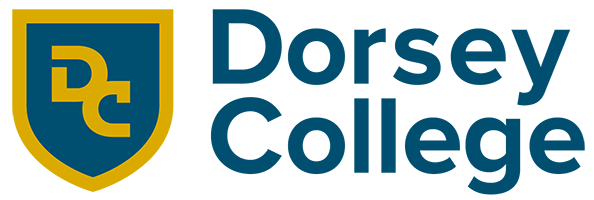What does it look like to be a medical assistant student, and what should you expect from your MA program? The medical assistant (MA) profession is a fast-growing, rewarding career path. 1 It’s a great route to pursue if you’re passionate about healthcare and want to make a difference in patient care while working in a supportive, fast-paced environment. If you’re curious about the day in the life of a medical assistant student, including their educational journey, read on!
Explore Dorsey College’s medical assistant program
What a day in the life of a medical assistant student may look like
A medical assistant student’s life can be busy but fulfilling. If you enroll in a quality MA program, your experience can be incredibly rewarding as you prepare for your future career. It may take some time to get used to your new routine, though. As a medical assistant student, you’ll need to learn to balance:
- Classes and coursework
- Hands-on training
- Additional studying
- Time management
- Your personal life
Classes
Part of your medical assistant program will be spent attending classes. The curriculum usually covers a broad range of subjects, from anatomy and medical terminology to administrative tasks such as coding and billing. As a medical assistant student, you can expect to have a structured schedule, with different blocks dedicated to each subject.
In addition to core medical concepts, MA programs often cover additional subjects such as:
- Communication skills
- Ethics
- Patient interaction techniques
- Organization skills
These “soft skills” are vital for success in any healthcare environment, but especially as a medical assistant. This healthcare career path requires a blend of technical and soft skills. As far as your daily workload as a medical assistant student, that will vary depending on the school and specific program. However, you will typically need to dedicate significant time to studying, completing assignments, and preparing for exams.
Medical assistant classes are designed to build your knowledge gradually. Each lesson will often build on previous material, and regular assessments will help gauge your progress. Some of your coursework will also include hands-on learning. This is where you take the theoretical knowledge you’ve learned and actually practice it. You may need to make adjustments depending on your learning style to make sure you can grasp all the concepts.
Balancing daily life
Balancing classes with other responsibilities like work, family, or social life is one of the most common challenges for medical assistant students. Time management becomes essential. Many medical assistant programs are designed with flexibility in mind, offering evening or part-time schedules for students who have other obligations.
Whether you’re attending school full-time or balancing part-time education with a job, staying organized is crucial. A typical day might involve attending lectures in the morning, working on assignments in the afternoon, and studying in the evening. Finding time for self-care, such as exercise, relaxation, or hobbies, is also key to avoiding burnout. Setting clear priorities, using time management tools, and maintaining a balanced routine can make the journey more manageable.
Medical assistant student educational journey
Becoming a medical assistant involves an educational journey that blends theoretical classroom learning with practical, hands-on experience. Understanding how these elements come together can help you prepare for what’s ahead.
Classroom Learning
Classroom learning is the foundation of your medical assistant education. Most programs will start by teaching you the fundamental concepts you need to know, including:
- Anatomy
- Medical terminology
- Healthcare ethics
- Legal considerations
- Communication
In these classes, you can gain a solid understanding of how the human body works and the specific medical terms used to describe conditions, treatments, and procedures.
In addition to clinical knowledge, medical assistant students can learn about the administrative side of healthcare. This includes courses in:
- Medical billing
- Coding
- Electronic health records (EHR) management
Understanding these aspects is crucial, as medical assistants often play a dual role, assisting with both patient care and administrative tasks in a medical office. They are needed in both settings on any given day. During classroom sessions, you’ll also practice critical thinking and problem-solving skills, which are essential when working in a clinical environment. Expect to engage in group projects, quizzes, and exams that will test your knowledge and help you retain information.
Hands-on Training
One of the most exciting and vital parts of your MA program is the hands-on training. Medical assistant students typically engage in clinical labs where they practice procedures like:
- Taking vital signs
- Administering injections
- Drawing blood
This phase of the program allows students to apply what they’ve learned in the classroom to real-world scenarios, which helps bridge the gap between theory and practice. During your hands-on training, you will likely work with medical equipment, practice sterile techniques, and learn how to interact with patients professionally. These skills are essential for success in the workplace and will give you the confidence needed to perform effectively in a clinical setting.
Many medical assistant programs also offer externships, which provide real-world experience in a healthcare setting under the supervision of experienced professionals. This practical exposure helps students gain confidence and prepares them for entry into the workforce after graduation.
Challenges and Rewards of Being a Medical Assistant Student
Being a medical assistant student comes with its fair share of challenges, but it’s a rewarding journey for those dedicated to pursuing this career. One common challenge students face is the fast pace of the program. Medical assistant programs are often shorter than other healthcare education pathways, meaning there’s a lot to learn in a relatively short period. This requires excellent time management, focus, and dedication to succeed.
Another challenge is the balance between theoretical knowledge and practical application. Some students may find certain subjects like anatomy or medical coding challenging, while others may struggle with the hands-on components like phlebotomy or patient interactions. However, consistent practice and support from instructors can help students overcome these obstacles. Be ready to flex your mental muscles!
The rewards of being a medical assistant student, however, far outweigh the challenges. One of the biggest rewards is the ability to make a difference in patients’ lives. Medical assistants play a vital role in patient care, ensuring that patients receive the attention and care they need during their visit to a healthcare facility. As a medical assistant, you will interact with patients daily, which can be incredibly fulfilling.
Ready to get started on this career path journey?
If you’re passionate about healthcare and are ready to embark on a fast-paced, rewarding career, becoming a medical assistant could be the perfect fit for you. Medical assistant students enjoy a well-rounded education that prepares them for a versatile and impactful role in healthcare. From classroom learning to hands-on training, the journey is challenging but full of rewards.
Whether you’re fresh out of high school, looking to change careers, or seeking a pathway into the medical field, enrolling in a medical assistant program could be your first step towards a fulfilling and dynamic career. With a growing demand for medical assistants across the healthcare industry, now is the perfect time to begin your journey. If you’re ready to pursue a career training in Michigan, click the button below to learn more about the robust program offered at Dorsey College.
1. Bureau of Labor Statistics, U.S. Department of Labor, Occupational Outlook Handbook, Medical Assistants,
at https://www.bls.gov/ooh/healthcare/medical-assistants.htm (visited October 01, 2024).

